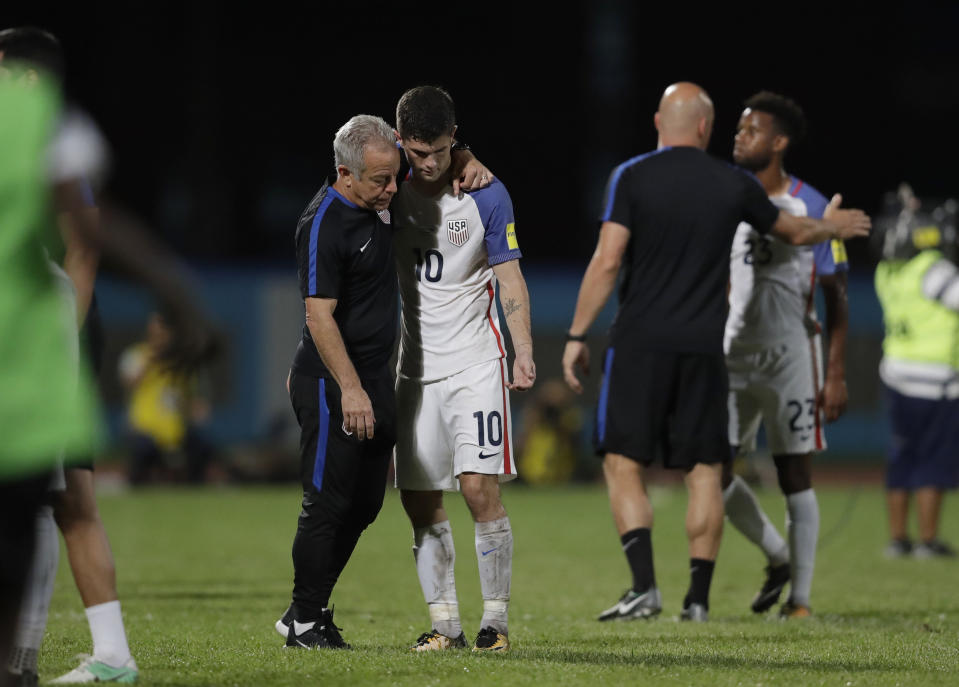Eight years is a long time to wait between World Cups
The magnitude of this moment for U.S. soccer is something that cannot be calculated, because of all the little moments that won’t happen.
Tuesday’s devastating 2-1 loss to Trinidad and Tobago eliminated the Americans from the World Cup, but it eliminated a lot more than that.
There will be no highlights of Christian Pulisic on the biggest world stage next summer in Russia. There will be no local news reports from overflowing pubs in Chicago and Portland and San Jose. There will be no Tim Howard memes, no Twitter debates about Bruce Arena lineups, no late-night TV circuit for Bobby Wood or DeAndre Yedlin.
And perhaps most importantly, there will be no opportunities for little kids across the country to watch Team USA play in the World Cup for the first time. Those kids will have to wait until 2022 at the earliest, and that is a long time for a 9-year-old who doesn’t remember watching in 2014 and will be a teenager the next time around. How long is eight years? Eight years ago, the iPads so many of us will use to watch 2018 World Cup highlights did not exist.
Granted, it’s not like the World Cup is canceled. A lot of people will still watch and be captivated by Lionel Messi and James Rodriguez and so many other superstars. Soccer in America is not going to spiral into horse racing because of one bad match. The foundation of interest and passion for the sport is still very much there.
Still, the World Cup is a global event, and it is once every four years, and that’s a lot to lose considering what happened just last Friday in Florida. The energy in the brand-new Orlando City Stadium during a 4-0 U.S. romp over Panama was tangible – especially after a magnificent Pulisic goal – and it promised much more in the months ahead. And that momentum was quite literally built in the wake of the last World Cup.
Four years ago, Orlando’s stadium and its two pro teams did not exist, and Pulisic was 15. Yes, the women’s national team had a huge role in the growth of soccer in the U.S. over this cycle, but so did the men getting out of the group stage and making millions of people change their summer plans to watch them against Germany and Ghana and Portugal. Viewership of soccer in the U.S. has eclipsed 20 million on five occasions, and four were for World Cup matches in the last cycle. (One was for the women’s final.)

So even if the U.S. didn’t make it out of the group in Russia, that’s roughly 70 million viewers who won’t be watching Team USA next summer. Then there are the pre-World Cup friendlies that won’t be appetizers for the big tournament. That counts, too.
And what of North American leagues? In 2013, the year before the Brazil World Cup, overall attendance in the USL was 445,709. By 2015, that number had boomed to 1,132,218. This season, the league estimates 2 million spectators. Yes, those numbers are boosted by expansion, but even that indicates what one four-year period can do. (There are now more than a dozen USL players on America’s U-20 and U-17 teams.) Will the next four years see a tapering off in that buzz? Ideally it won’t, but now that question has to be asked with a certain foreboding. The MLS saw year-over-year attendance growth of 12.6 percent in 2015, and it’s foolish to think none of that came because of U.S. soccer participating in the World Cup.
The other loss is a gap in enthusiasm. Pulisic is still a godsend to U.S. soccer – age 19 and getting better constantly – but much of the discussion in the short term will include blame and regret. Should Jurgen Klinsmann have been kept? Was Tim Howard too old? Was overall leadership missing? Will things really be better under the next regime? Will the U.S. contend for a World Cup in the next decade or will fans be waiting for a promised land that never arrives?
‘Wait Till Next Year’ stings a bit more when there is no next year. ‘I Believe That We Will Win’ doesn’t resonate as much after belief turned to dismay.
The U.S. men’s team lost at home last November to Mexico, lost at home in September to Costa Rica and lost its deciding match to Trinidad and Tobago, the worst team in the Hex. Those are some serious missed opportunities, but the biggest missed opportunities are in the matches they will not play.
The loss is not only theirs. It’s ours.
Read more from Yahoo Sports:
• Trump, once again, is wrong about NFL, Roger Goodell
• Jerry Jones makes new enemy in anthem battle
• 5 main culprits in shocking U.S. World Cup failure
• D-III player kicked off team after kneeling for national anthem

